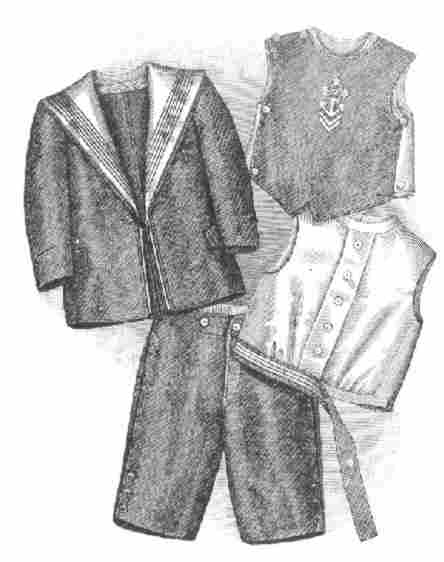
Sailor Suit Components French Magazine

Figure 1.--This French fashion magazine illustration shows some the garments that made up a sailor suit. There is no headwear. It does show the kneepants, a jacket (rather than a middy blouse), dickie (referred to as a vest), along with a fourth garment (the white one) which we are unsure about. The magazine appeared in 1895 and was described as suitable for a 7-8 year old boy.
|
This French fashion magazine illustration shows some the garments that made up a sailor suit. There is no headwear. It does show the kneepants, a jacket (rather than a middy blouse), dickie (referred to as a vest), along with a fourth garment (the white one) which we are unsure about. The magazine appeared in 1895 and was described as suitable for a 7-8 year old boy. The garments shown here are for the most part obvious depictions. They seem comparable to the garments worn in other countries. The only garment we are unsure about is the white garment.
Jacket or Blouse
The jacket or blouse could take varios forms. The blue jacket shown here (upper left) is a button up garment. There were also pull-over middy blouses. We have seem similar styles in America, England, and Germany.
Dicky or Shield
The sleeveless blue garment seen here (uppe right) is referred to as a dickey or shield. A sailor suit could be worn woyhout a dickey, especially during the Summer. The dickey here has a anchor emblem. Suc naval emblems were common. The dickey could be plain. Stripes were also common, but the stripes seem to have often been "T"shirt-like commons. There were other types of dickeys. Some were not separate garments at all, but rather just cloth sewn into the jacket or blouse garment. While the dickey here is a kind of vest, it should not be assumed that this was the only approach. We think that stripped dickies were more like early "T" shirts (We're not sure about the sleeves). We also note that some sailor outfits had detachable inserts. See for expample sailor outfits in the Wards 1914 Summer catalog.
White Garment
The item that we are not sure about here is the white garment (middle right). This garment did not commonly come with the sailor suits sold in America. We assume tht it is the front of the garment. we thought that it was an underwaist. The primary reason we think this is the stiffening tape shown at the waist. We believe mothers would have sewn buttons on this tape to hold up the kneepants. There are no suspender straps for long stockings because French boys did not wear long stockings as commonly as American boys. It would have been worn under the dickey. Not all readers, however, agree with this assessment. One reader writes, "No, the sleeveless white garment is not really an underwaist. It doesn't have a support function (for trousers or long stockings). Notice that
there are no buttons or button holes around the waist to attach to the trousers, which already have buttons on them, maybe for suspenders. It appears to be a sleeveless shirt worn under a blouse. It looks a bit like an underwaist (since it is a sleeveless, vestlike, garment and white), but it is does not really seem to be underwear. Presumably it would be worn on top of the underwear. Since this is a French garment, maybe long stockings were not
worn with the suit and therefore no need for the usual underwaist for the support of long stockings." A reader writes, "I don't think this whitle sleeveless garment is underwear, but am unsure about the strip that peels off at the waistline. Could this be a kind of built-in belt to conceal waist buttons underneath? If this is the
case, it would be a shirt-waist with concealed waist buttons. I remember seeing a Youth's Companion page on HBC that has a garment that conceals buttons. It is noted in the ad copy. But I can't recall which one it was." HBC doesn't understand why the buttons needed to be concealed as this garment was covered by the blouse and pants. The strip showing at the bottom of the garment looks rather like tapes that mothers used to sew into garments to better support buttons used in a support function. Now I remember what I was thinking of when I mentioned the band concealing buttons. I was a bit off base here. What I was recalling somewhat
inaccurately was the HBC page about the ad for Jack Tar Tuckin Pants (1930, Good Housekeeping Magazine) in our catalogue section. This garment susbstitutes an elasticized band for the more common buttons on button-on short pants which apparently a lot of boys didn't like. They seem to have objected to the "buttoned up" feeling. The Jack Tar short trousers solve the problem of keeping the boy's waist tucked in without the use of buttons to fasten the shorts to the shirt
or waist. It's not quite the same thing as I thought, but it is perhaps related."
Knee Pants
Sailor suits through the 1910s were commonly worn with kneepaats. Notice the three buttons here at the knee hem of kneepants shown here. There were from thebeginning also long pants sailor suits.
HBC

Navigate the Boys' Historical Clothing Web Site:
[Return to the Main sailor suit component page]
[Introduction]
[Activities]
[Biographies]
[Chronology]
[Clothing styles]
[Countries]
[Bibliographies]
[Contributions]
[FAQs]
[Glossaries]
[Satellite sites]
[Tools]
[Boys' Clothing Home]
Navigate the Historic Boys' Clothing Web sailor pages:
[Middy blouse]
[Reefer jackets]
[Sailor dresses]
[Other sailor styles]
[Sailor hats]
[Middy suits]
[National sailor suits]
[The Royals]
[Ring bearer/page costumes]
Created: 10:34 PM 2/8/2005
Last updated: 5:14 PM 3/2/2005



